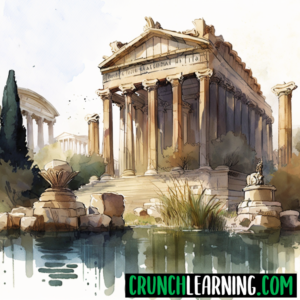The Acropolis of Athens is one of the most iconic structures in the world, standing as a symbol of the legacy of ancient Greece and its rich cultural heritage. The Acropolis is a complex of buildings and structures located on a hill overlooking the city of Athens, and it is a testament to the ingenuity and creativity of the ancient Greeks. In particular, the Acropolis of Athens showcases the amazing architecture of the ancient Greeks.
History of the Acropolis of Athens
The Acropolis of Athens was built on a high hill overlooking the city and was originally used as a fortress to defend against invading forces. Over time, however, it became a symbol of Athenian power and a center of religious and cultural life.
The Acropolis was built in the 5th century BCE, during the height of the Athenian Empire. The most famous structures on the Acropolis are the Parthenon, the Erechtheion, and the Propylaea, all of which were built during this period. The Parthenon, a temple dedicated to the goddess Athena, is considered one of the most important examples of classical Greek architecture and is known for its intricate sculptures and friezes. The Erechtheion is a temple dedicated to both Athena and Poseidon and is known for its distinctive “Porch of the Maidens” with six female figures as columns. The Propylaea is a monumental gateway that served as the entrance to the Acropolis.
The Acropolis was also home to other structures such as the Temple of Athena Nike and the Theater of Dionysus. These structures were used for religious and cultural events such as plays, festivals, and ceremonies.

Significance of the Acropolis of Athens
The Acropolis of Athens is located on a hilltop in the city of Athens, Greece. It was the center of political, economic, and religious life in ancient Athens and is considered one of the most important and iconic architectural complexes in the world.
Many cities in Ancient Greece had a central high point that was on a rocky mound, which the Greeks referred to as ‘acropolis’. For example, the word ‘acropolis’ means ‘high city’ in Greek. It was on the acropolis that important temples and buildings were often located. The most famous acropolis in Ancient Greece was the one located in Athens. It still exists today and is one of the most important historical sites in the world. In fact, it is a UNESCO (United Nations Educational, Scientific and Cultural Organization) World Heritage Site, which means it’s been identified as a culturally important place to all of humanity.
The Acropolis was an important religious and cultural center for the ancient Athenians. It was considered the sacred home of the goddess Athena, the patron goddess of Athens, and was the site of important religious ceremonies and festivals. Additionally, the Acropolis was also a political center, where important decisions were made by the city’s leaders.

Summary of the Acropolis of Athens
In summary, the Acropolis of Athens is an ancient citadel located on a hilltop in the city of Athens, Greece. It was built in the 5th century BCE, during the height of the Athenian Empire, and it has some of the most famous structures such as the Parthenon, the Erechtheion, and the Propylaea. The Acropolis was an important religious, cultural and political center for the ancient Athenians and it has had a lasting legacy and continues to be an important symbol of ancient Greek culture and civilization. It is a UNESCO World Heritage Site and is one of the most visited tourist destinations in Greece.
The Acropolis of Athens is a testament to the creativity and ingenuity of the ancient Greeks, and it remains one of the most iconic structures in the world. Whether you’re a student of history or simply interested in the cultural heritage of ancient Greece, the Acropolis is a must-see destination for anyone visiting Athens.







